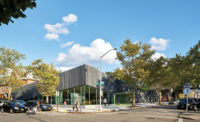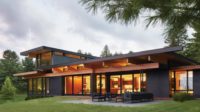Culver City, California
In 2000, California State Parks (CSP) spent just over $41 million acquiring 57 rolling acres for parkland after citizens of Culver City, California, had protested a planned residential development on the site. The land rises more than 400 feet above the L.A. basin — high enough that the roar of Interstate 405 begins to fade into the sound of wind howling through the hills. Turning the land into a vibrant state park would be a challenge: The previous owner had discarded construction materials on-site, cleared the area of vegetation, and flattened the ridgeline, allowing invasive grasses to overtake indigenous plants.
Program
The state government allocated money to build “improvements” on the site, including hiking trails and a visitor center that would educate parkgoers about the surrounding environment. The design would have to be unobtrusive — a CSP administrative code prohibits buildings “which are attractions in themselves.” According to Barney Matsumoto, who oversees construction in Southern California’s state parks, Safdie Rabines was chosen for the project in large part because the firm’s previous work tended to “tread lightly on the landscape.”
Baldwin Hills’ program evolved through a series of public workshops with the local community (which initially requested that the park include amenities such as soccer fields and playgrounds before warming up to CSP’s sparer, more naturalistic vision). Working closely with landscape architects Wallace Roberts & Todd (WRT) and California State Parks designers, Safdie Rabines began overhauling the site in 2006.
Solution
The buildings seem to have been designed in accordance with the Hippocratic oath: Above all, they do no harm to the landscape (or very little, anyway). Safdie Rabines’ master plan includes a visitor center, support building, and open-air pavilion, in addition to a garden and a series of trails.
A concrete path leads from a parking lot to the visitor center, which houses an exhibition on the area’s ecology. The path continues outside the building before it connects with an ADA-accessible trail leading to the area’s highest point (hikers can also access the overlook via a staircase, built with concrete found on-site, that ascends from Culver City below). On top of the hill, visitors get an unobstructed view of the L.A. basin, where mountains and the Pacific Ocean frame the relentless urban sprawl. It’s a jarring contrast: Walking back down from the lookout, a visitor may see a Monarch butterfly flitting past oil derricks that slowly pump crude at the park’s edge.
At every turn, Safdie Rabines’ design engages with the environment. The crescent-shaped visitor center nestles against a regraded ridgeline so the earth’s insulation reduces heat load. The building’s glass wall looks over the site, while a butterfly roof shades both the transparent facade and a walkway beside it. Although a HVAC system mechanically cools the visitor center when needed, operable windows and clerestories provide natural ventilation. Pivoting glass doors at each end of the visitor center can also open to induce a breeze, blurring the line between inside and out.
Commentary
In creating unobtrusive facilities that increase public access to the landscape, the Safdie Rabines design succeeds. By integrating a simple building and its environment, the architects demonstrate a respect for the park itself.
But the project has been hamstrung by a dismal economy. California’s unique financial restraints — among them, a rule that a supermajority of state lawmakers is required to pass tax increases — helped put the state into debt some six months before America’s current recession began. Financial woes threaten to close a majority of California’s 279 state parks, and CSP can only afford to staff Baldwin Hills on weekends. Parks officials said in interviews that the National Park Service and the Audubon Society might provide volunteer employees, but no formal arrangement exists yet.
“The irony,” says Matsumoto, “is that we built these nice facilities, but we can’t operate them because of lack of funding.” So on a hill above Los Angeles, a Modern arc of glass and concrete sits locked up five days a week, the wind whistling through a crack between its closed doors.
Location: Kenneth Hahn State Recreation Area, Culver City, California
Completion Date: April 2009
Gross square footage:
7200 sq.ft.
Total construction cost:
$7.5 Million
Owner:
California State Parks and Recreation
Architect:
Safdie Rabines Architects
1101 Washington Place
San Diego, CA 92103
P. 619.297.6153
F .619.299.6072
PeopleOwner: Architect: Personnel in architect's firm who should receive special credit: Architect of record: Taal Safdie (Registered Architect) Engineer(s): MEP: Integrated Engineering Civil: Fuscoe Engineering Consultant(s): Habitat Restoration: Earthworks General contractor: Photographer(s):
|
ProductsExterior cladding: Metal Screens: GC Welding Roofing: Metal: Atlas Sheet Metal Custom Scupper & Downspouts: Atlas Sheet Metal Windows: Glazing: Doors: Metal doors: Direct Door & Hardware Aluminum & Glass Flolding: Nana Wall Systems, Inc. Herculight Doors: Rainbow Glazing Interior finishes: Cabinetwork and custom woodwork: Advanced Woodworks, Inc. Carpet: Atlas Carpet Mills, Inc. Furnishings: Conference Room Table: Vecta - Ginko Theater Chairs: Vecta - Lyric Lighting: Track lighting: Lightolier Pendant lighting: Bruck Lights Custom Metal Light Soffit: GC Welding Exterior: Bega Lighting Plumbing: |





